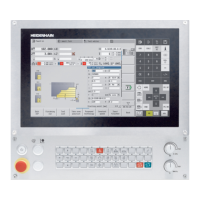Teach-in | Milling cycles
5
HEIDENHAIN | MANUALplus 620 | User's Manual | 12/2017
369
RB: Return plane
SCI: Safety clearance in the working plane
SCK: Safety clearance in infeed direction
Further information: "Safety clearances SCI and SCK",
Page 180
MT: M after T: M function that is executed after the tool call T
MFS: M at beginning: M function that is executed at the
beginning of the machining step
MFE: M at end: M function that is executed at the end of the
machining step
WP: No. of spindle – Displays which workpiece spindle is used
to execute the cycle (machine-dependent)
Main drive
Opposing spindle for rear-face machining
BW: Angle in the B axis (machine-dependent)
CW: Reverse the tool (machine-dependent)
HC: Shoe brake (machine-dependent)
DF: Miscellaneous function (machine-dependent)
Type of machining for technology database access:
Milling
Notes on parameters and functions:
Machining of contour or pocket: Defined with
Overlap factor U
Milling direction: Depends on definition of Mill
cutting direction H and the direction of tool rotation
Further information: "Milling direction for contour
milling", Page 388
Milling cutter radius compensation: Effective
(except for contour milling with J=0)
Approach and departure: For closed contours, the
starting point of the first element (in rectangles,
the longer element) is the point of approach and
departure. The tool approaches directly or on an arc
according to Approach radius R
Contour milling JK defines whether the milling
cutter is to machine on the contour (center of milling
cutter on the contour) or on the inside/outside of the
contour
Pocket milling—roughing (O=0): Use JT to define
whether a pocket is machined from the inside toward
the outside, or vice versa
Pocket milling—finishing (O=1): First, the edge
of the pocket is machined; then the pocket floor is
machined. With JT you define whether a pocket floor
is to be finished from the inside towards the outside,
or vice versa

